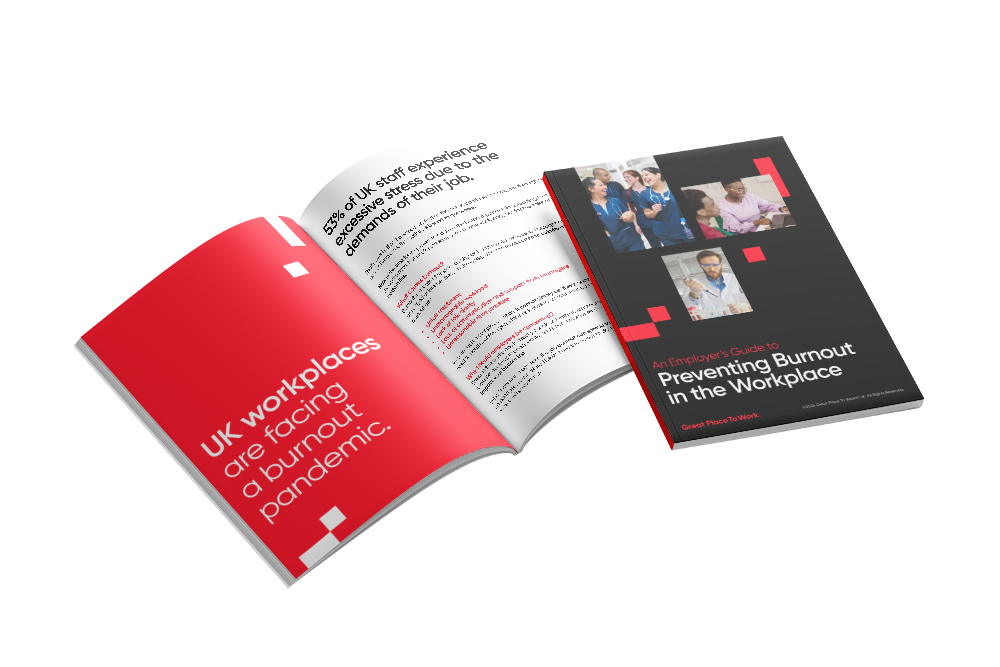UK’s Best Workplaces™ share their best practices for building a more trans-inclusive workplace.
When it comes to LGBTQ+ employees (as with any other marginalised group in the workplace), true inclusion is about more than just hiring a diverse workforce.
It’s about the organisation treating ALL people equitably, and fostering a culture that allows every individual to feel safe to bring their whole selves to work.
To be a truly trans positive organisation, support for trans employees needs to be deliberate, holistic and active over the long-term. But before we dive into best practices, we need to first understand what it means for an employee to identify as ‘transgender’.
Identifying as Transgender at Work
‘Trans’ or ‘transgender’ are umbrella terms that can be used for anyone who identifies with a gender which does not match their assigned sex at birth.
Being trans is based on one’s internal sense of self ; how one feels and expresses one’s identity. This can be male, female, a mixture of both (such as bigender), no gender at all (agender), or exist completely outside of these (such as pangender or polygender).
Transgender vs Cisgender
When someone feels their assigned sex at birth does match the gender they identify with, one is considered ‘cisgender’. Trans employees therefore will never identify as ‘cis’ or cisgender.
What Trans-inclusivity Looks Like in Practice
Here are some of the ways in which the 2021 UK’s Best Workplaces™ are cultivating a trans-inclusive workplace culture:
1. Pronouns
Personal pronouns (she/he/they) are our subjective identifiers which allow all of us – whether trans or cisgender – to choose how we would like others to address us in and outside of work.
Arguably one of the easiest ways to show your support of LGBTQ+ employees is to encourage the use of personal pronouns in email signatures and/or profiles on company channels like Microsoft Teams, Zoom and even LinkedIn.
This allows trans employees to use language which fits their identity, making them feel acknowledged and valid. It can also help lessen fears some cisgender employees may have of using the incorrect pronoun for a trans colleague.
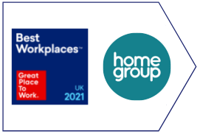 As a Stonewall Diversity Champion, Home Group Limited is a prime example of an organisation which understands the importance of language and acknowledges the daily struggles LGBT employees face in hiding parts of who they are.
As a Stonewall Diversity Champion, Home Group Limited is a prime example of an organisation which understands the importance of language and acknowledges the daily struggles LGBT employees face in hiding parts of who they are.
“Often it comes down to really simple things, like a gay colleague being too afraid to use the correct pronouns when talking about their partner because they’re so terrified of being ‘found out’,” explains Ronika Cunningham, Engagement Manager at Home Group.
“And this sort of thing can go on for years if someone isn’t working in a place where they can fully be themselves. One of our colleagues is now in his sixties and recently shared with me that Home Group is the first company in his whole career that made him feel comfortable to be openly ‘out’. This is what it’s about – you can change someone’s life!”
2. Helping transition
It’s important to keep in mind that not all gender transitions are the same. While some trans employees will choose to transition socially (such as coming out as trans to friends, family and colleagues), others may opt to transition medically (which may involve ongoing hormone treatments, for example).
Transitioning can therefore be an incredibly daunting experience, regardless of how a trans employee chooses to do so, or how long the process may take.
To ensure the success of any workplace transition, it’s crucial that everyone plays their part.
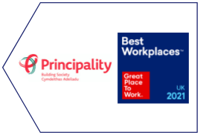 Alongside their introduction of gender-neutral bathrooms in some office locations and a relaxed dress code to support freedom of gender expression, Principality Building Society has an extensive Gender Identity policy as part of their inclusion strategy.
Alongside their introduction of gender-neutral bathrooms in some office locations and a relaxed dress code to support freedom of gender expression, Principality Building Society has an extensive Gender Identity policy as part of their inclusion strategy.
The policy includes an action plan specifically designed to support any colleagues going through their gender transition.
“We pride ourselves on being a workplace that places colleague wellbeing at its core,” explains Lorna Kerr, Chief People Officer at Principality.
“The support provided for current and future transgender colleagues focuses on key areas that we regularly review and continually strive to improve upon, such as raising cognizance of the societal issues faced by the transgender community…It’s all part of our holistic approach to ensuring our workplace culture is one that celebrates difference and advocates inclusion.”
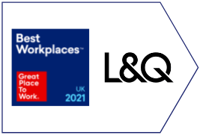 This is echoed by Jan Gale, Assistant Director of Diversity and Inclusion at L&Q:
This is echoed by Jan Gale, Assistant Director of Diversity and Inclusion at L&Q:
“At L&Q, our policy and process around transitioning in the workplace was first introduced in 2017. One of the ways we support our trans employees going through a transition is recognising that they may need to take time off for medical appointments and allowing them to do so without the need to use up their annual leave days.
“Our leadership was massively receptive to these sorts of ideas, which were presented to HR by some of our LGBT staff. We’re then able to provide the space and support needed for staff to realise ideas fairly quickly, compared to other organisations where there are many more barriers to overcome.”
3. Rethinking healthcare benefits
How comprehensive is your transgender health insurance cover?
Organisations are consumers of healthcare offerings, and as such can advocate on behalf of trans employees signed up to their group health insurance plans.
For example, you may need to work with your insurance administrator to ensure any exclusions in your current plan have been updated to provide sufficient cover for all employees.
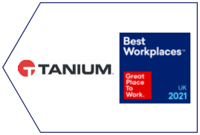 Tanium, for example, recently introduced fertility benefits which includes access to evaluations, preservation, IVF, surrogacy and adoption, with 100% reimbursement of eligible expenses up to $10,000.
Tanium, for example, recently introduced fertility benefits which includes access to evaluations, preservation, IVF, surrogacy and adoption, with 100% reimbursement of eligible expenses up to $10,000.
The benefits provide all team members with equal access to quality fertility-related care, regardless of age, sex, sexual orientation, or gender identity.
4. Supportive technology
Ensuring LGBTQ+ employees are able to choose the appropriate gender identity on a New Starter Form is one example of how you can create a more inclusive workplace right from the induction stage.
On the other end of the employee journey, those who eventually leave the organisation can be offered the opportunity to complete a confidential online Leavers Questionnaire to help inform future decisions to keep improving your trans inclusion at work.
And it's not only at the start and end of a trans employee's tenure where tech matters.
“Updating our Oracle system, for example, is something we’ve made a conscious effort to invest in because we know that as people’s personal circumstances change, it’s important that they can make changes to their own profile on our system as soon as they feel ready to do so,” explains Jaya Sample, HR Manager at Home Group.
“And in surveys as well - it’s essential for us that everyone (regardless of gender, race, age…) can feel that their identity is represented so they disclose this information to us instead of clicking a box with ‘Prefer not to say’. Using this data, we can continue to monitor ourselves in terms of how we're serving and support all of our diverse groups within the Home Group family.”
Jan agrees:
“Start with the data. Getting an organisation-wide snapshot of how people feel about inclusion here at L&Q would be very difficult without a tool like the Trust Index© survey,” she says.
“By breaking down results according to protected characteristic, we can see which groups of colleagues score disproportionately lower (or higher) than other identities, so we know where to focus our attention every year.
“With our LGBT group, for example, we recently found that these employees scored slightly lower in the area of line management. So it became time to ask ourselves: ‘What do we need to do in our line management to make it more LGBT-inclusive?’. Whether that means working with our internal Spectrum network or an external organisation, we may not know immediately. But starting with the data lets us know which questions are the right ones to ask in the first place.”
5. Employee networks
LGBTQ+ staff-led networks provide an effective, engaging and inclusive method for developing a more trans- or rainbow-positive organisation.
Both Home Group’s 'Pride at Home' and L&Q’s 'Spectrum' employee networks have been recognised by Stonewall as one of the top 30 networks in the UK.
“I started Pride at Home about 8 years ago and we have over 100 members in the group now!” says Ronika. “We welcome anyone who identifies as LGBTQ+ but also do a lot of work to help other non-LGBTQ colleagues become allies of our community, which is so important.”
Cultural awareness is key to allyship. Here are just some of the ways in which the Pride at Home network have raised awareness and created safe spaces for colleagues to speak on trans issues, ask questions - and have some fun along the way:
- LGBTQ+ quizzes and questionnaires covering key topics such as what language to use when interacting with or speaking about the trans community;
- A calendar dedicated to celebrating LGBTQ+ events such as Pride Month, Trans Day of Visibility and Trans Day Of Remembrance;
- Ensuring trans women are included in Home Group’s company policy around menopause;
- And encouraging openly ‘out’ colleagues to become visible representatives to help others feel more comfortable to declare their gender identity to the organisation.
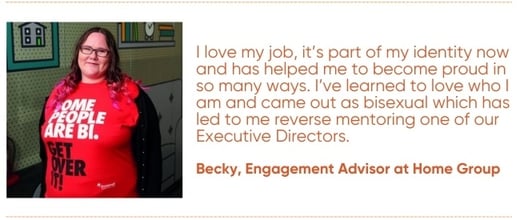
For L&Q’s Spectrum network, supporting local LGBTQ+ charities has been a key feature of their awareness campaigns. This includes activities like a quiz on World Aids Day in support of Terrence Higgins Trust; and a Eurovision sweepstakes with proceeds donated to the Mermaids charity.
“We believe networks should be by staff, for staff, and for the benefit of all staff,” says Jan. “As the organisation, it’s our job to prepare the ground, making it clear that there is space for these groups and that it’s about how they want to impact change for the good of all colleagues, no matter where they are based or what their demographics.”
To further their mission of creating inclusion for all, Spectrum also collaborates with other employee networks in the company. One example is their recent partnership with Inspire - L&Q’s gender equality network – to host an International Women’s Day event during which a trans woman shared with attendees how being trans impacts her employee experience as well as her personal life.
To enable sector-wide reach, Spectrum also became part of the external ‘Houseproud’ consortium working in the social housing sector to lobby several social housing organisations (including L&Q, Optivo and others) to come together in commissioning research on LGBTQ+ residents in social housing.
“This work has influenced how we deliver services to be more inclusive to our residents as well. It shows that staff networks can be so much more than what we could have imagined. These networks really work when people are empowered to lead themselves and given corporate support, rather than the company saying ‘these are the ways in which we think we should impact change.’”
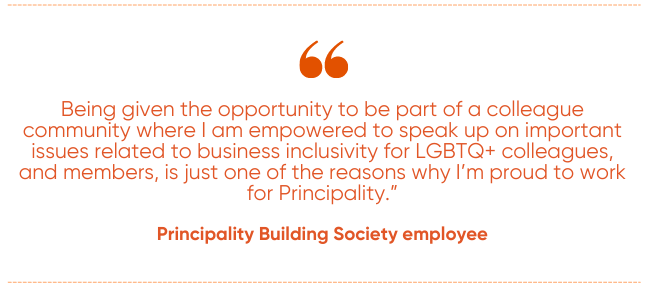
Since its formation in 2018, Principality’s ‘LGBT+ & Friends Network’ has worked hard to enable positive change internally by influencing on the delivery of awareness campaigns such as LGBT+ History Month, Pride Month and Inclusion Week.
“Colleagues also help organise key inclusion-focused activities such as Principality’s participation in Wales’ Pride celebrations – Pride Cymru – which works alongside community outreach which is undertaken via sponsorship activities such as LGBTQyrmu Pride and LGBTQ+ youth theatre projects,” says John Hoddinott, Internal Communications & Engagement Manager at Principality.
“The network comes to fruition via two groups of invested colleagues: a smaller ‘core group’ who meet monthly to drive forward the strategic goals of the network, and the wider network group who meet every two months in order to share information, experiences and provide peer support to one another. It’s a fully inclusive network welcoming all identities, including allies – or ‘friends’ as we prefer to call them.”
6. Reverse mentoring
Besides educating senior leaders on LGBTQ+ issues, Home Group’s reverse mentoring programme enables mentors to develop their own skills by learning from the leaders they mentor.
“We give our mentors the option to choose which leader they’d like to work with so it’s not a random partnership,” explains Jennifer Glover, People Development Advisor at Home Group. “This way, we ensure both parties benefit from the experience because there is growth on both sides resulting from their regular conversations and learning together.
“Sometimes it’s a simple chat about a specific topic that’s been in the news lately which a mentor can share insights on from their unique perspective. This is how we help our leaders become allies of the community, and it’s become a really powerful yet simple tool that gives everyone the freedom and psychological safety to ask questions.
"We also stress to all our colleagues that it's okay to make mistakes or call out assumptions that exclude the trans community, or any group of people here at Home Group. We're all learning all the time, and there's no shame in that - as long as we stay committed to learning together, and with the intention of making this a safe, happy environment for everyone.”
The bottom line
Employees who feel free to bring their full selves to work have increased energy, better performance and stronger relationships with colleagues.
When your organisation is a safe space for all employees (whether cisgender, or part of the LGBTQ+ community or any other marginalised group) you’ll be able to tap into the full potential of your workforce. And who doesn't want that?
Need Help on Your DEI Journey?
Our Insight Consultants can support you in measuring and improving equity and inclusion in your workplace.
To learn more about our Best Workplaces™ employer recognition programme, please click here.








